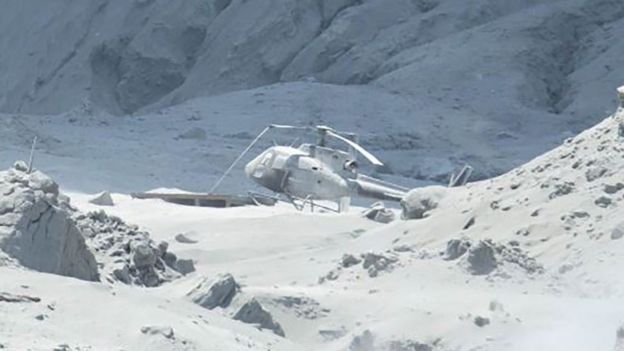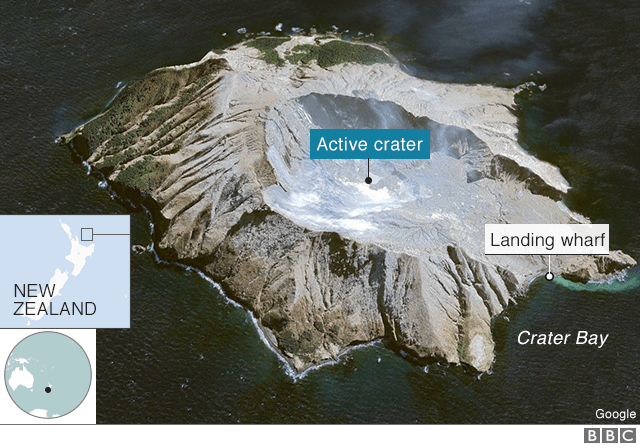Science Knew : Government Inaction
"It's now clear that there were two groups on the island -- those who were able to be evacuated and those who were close to the eruption."
"To those who have lost or are missing family and friends, we share in your unfathomable grief in this moment in time and in your sorrow."
"[Reconnaissance flights have flown over the island and] no signs of life have been seen at any point."
New Zealand Prime Minister Jacinda Ardern
"My God -- my family and I had gotten off it [the island] twenty minutes before, were waiting at our boat about to leave when we saw it."
"Boat ride home tending to people our boat rescued was indescribable."
Michael Schade, engineering manager, San Francisco, White Island tourist
"The phone rang at midnight. Then I heard a voice mail come on. It was my son."
"He said, Mom ... this is not a joke."
"A volcano erupted while we [he and his new bride] were on the island. We're at the hospital with severe burns."
Janet Urey, 61, nurse, Richmond, Virginia
"White Island has been a disaster waiting to happen for many years."
"Having visited it twice, I have always felt that it was too dangerous to allow the daily tour groups that visit the uninhabited island volcano by boat and helicopter."
Ray Cas, professor emeritus, Monash University, Australia
 |
| New Zealand's White Island volcano is showing increased seismic activity, putting recovery efforts on hold. AFP |
Roughly fifty kilometres from the east coast of New Zealand's North Island, immense plumes over the White Island volcanic eruption which Volcanologists judged shot 12,000 feet into the air, were visible from the mainland. The GeoNet science agency which operates the rim cameras and monitors volcanoes and earthquakes in New Zealand, on November 18 had raised the alert level on White Island from one to two. The agency had noted an increase in sulphur dioxide gas originating from magma deep in the volcano.
They warned that the island "may be entering a period where eruptive activity is more likely than normal."
Over the previous weeks, the volcanic tremor presaging violent activity had increased from weak to moderate strength. Knowing all this, it is beyond strange that the New Zealand government took no preventive action, cautioning tour operators to hold off on conveying tourists to the popular tour spot, and if it was determined that those businesses, concerned over their profitability, hesitated to take the caution seriously, they should have been given due notice that they would be held responsible should a tragedy of this magnitude occur.
 |
| An ash-covered helicopter on the island as the eruption took place Michael Schade |
The popular tourist area on the island holds an active volcano which last erupted in 2016. An active volcano with signals that activity has increased and the probability of an eruption seems likely, is no place for dozens of people to be milling about, climbing to the rim of the volcano itself, however spectacular that view is. People who approach the island as tourists reason, understandably enough, that they would never be permitted to make that trip if the government itself didn't feel it was safe. Obviously, they were wrong.
In the hour before the eruption, groups of people were captured on a crater rim camera walking toward and then away from the rim within the crater, where white vapour was billowing. The camera captures a group of people at 2 p.m. right at the volcano edge. Ten minutes later the group heads away from the rim, tracking along a well-worn path across the crater. In another minute the volcano erupts and those people who showed up on the camera footage are all assumed to have perished.
Forty-seven people were on the island, exploring its geology on Monday when the eruption occurred, five of whom have been confirmed dead, eight missing and feared dead, according to police. The first to be identified among the dead was an experienced guide for White Island Tours, Hayden Marshall-Inman. New Zealand's prime minister expressed appreciation for the selfless emergency response of first responders who went out in "extraordinarily dangerous circumstances" hoping to rescue people.
Thirty-one of those they succeeded in rescuing are in hospital, while three were discharged; the injuries are all the result of burns, with some of those injured in critical condition. New Zealanders and tourists from Australia, the United States, Britain, China and Malaysia are among those listed as missing, or among the injured. Between 30 to 38 people were visitors from the Ovation of the Seas, a Royal Caribbean cruise ship; twenty of the cruise guests were on the island at the time of eruption.
“We heard they [emergency services] were not coming to the island [given the extreme danger]."
“It’s their decision. I wasn’t involved in that. We just took care of our business [and flew in]."
"We found people dead, dying and alive but in various states of unconsciousness."
"It would take 20 minutes to get [back] out there. We know where they [dead bodies] are."
"Then we could bring them home."
Mark Law, 48, commercial helicopter pilot
"We interpret these signals as evidence of continued high gas pressures within the volcano."
"The situation remains highly uncertain as to future activity. Eruptions in the next 24 hours are still likely to occur."
GeoNet seismic monitoring agency
"There is a high level of uncertainty associated with this estimate and we are working to reduce that uncertainty."
"We also estimate the least likely scenario is a larger eruption."
GeoNet volcanologist Geoff Kilgour

Labels: Calamity, New Zealand, Volcanic Eruption, White Island

<< Home